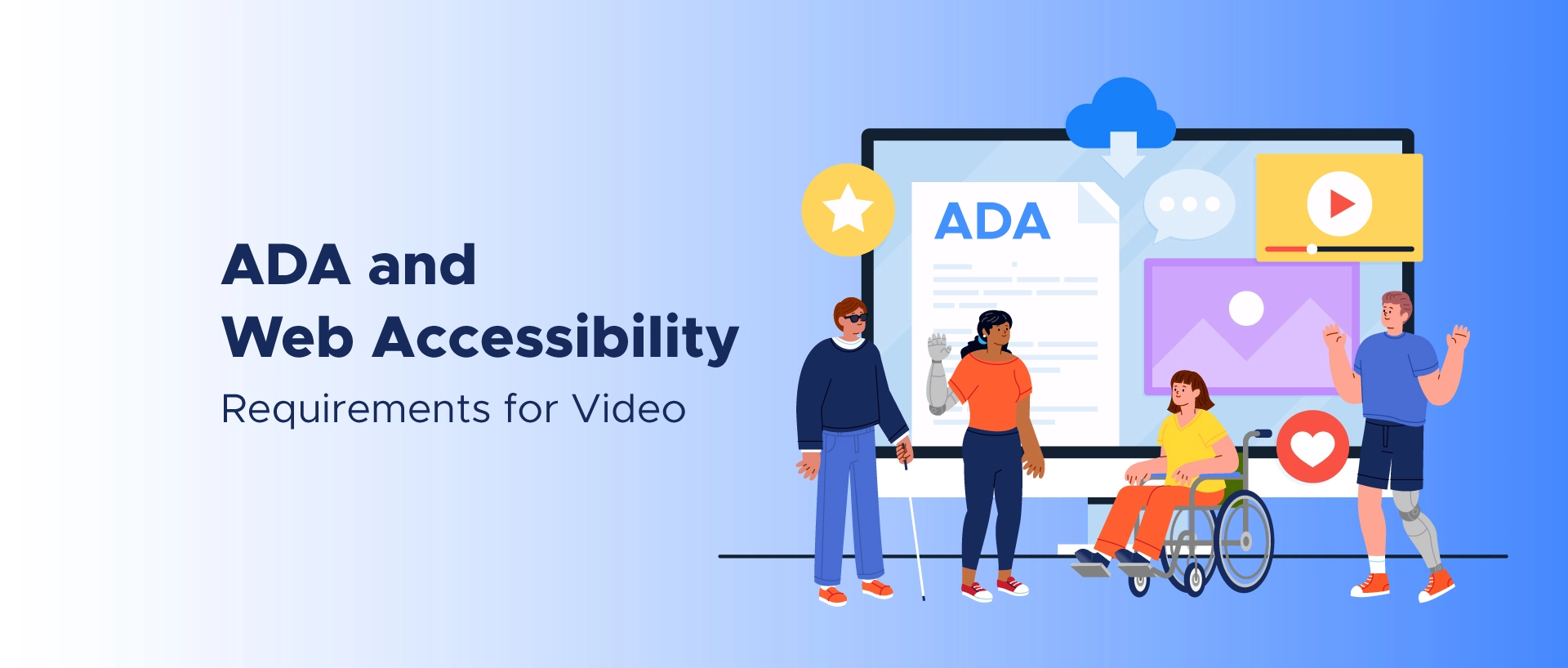
The Americans with Disabilities Act (ADA) is a nationwide law that forbids discrimination against differently-abled people in several aspects of life, including public accommodations, employment, and telecommunications. In the present time, there has been a growing recognition of the need for web accessibility to ensure equal and proper access to information and services for individuals with disabilities.
Accessibility for multimedia, such as videos, has become increasingly common on websites and digital platforms. As a result, ADA video requirements have become a significant component of web accessibility for video content. Let us understand the importance of video accessibility and how it benefits differently-abled individuals.
Video accessibility refers to the practice of making videos inclusive and accessible to all individuals, regardless of any hearing or language barriers they may have. By providing videos with suitable captions and transcripts, users can understand the content of a video even in noisy environments or situations where they cannot play audio. It ensures that no one is left out of important information or entertainment. Moreover, captions and transcripts can also be translated into different languages, allowing the content to reach a global audience and have a greater impact.
For example, imagine you recorded a conference presentation and shared it online. By including captions and transcripts in it, deaf or hard-of-hearing users can still fully understand the information being presented. Additionally, people who speak a different language can have the captions translated into their language, making the content accessible to a wider audience. It not only ensures inclusivity but also allows for effective communication and dissemination of knowledge on a global scale.
ADA video requirements for accessibility involve providing closed captions, audio descriptions, and transcripts for videos to make them accessible to people with hearing or visual disabilities. These features enable individuals with disabilities to fully understand and engage with the content, promoting inclusivity and equal access to information. Let us understand each of these essential features in detail.
ADA requirements for video closed captioning involve displaying text on the screen that corresponds to the dialogue and other relevant audio elements in the video. Captions are a significant component of video accessibility, allowing individuals with hearing impairments to understand the content. They should accurately convey dialogue, sound effects, and any other relevant audio information.
For example, imagine a student who is deaf and wants to watch a lecture video. By turning on closed captioning, they can read the text displayed on the screen and easily understand the content being discussed. It ensures that they are able to engage and participate in their education fully, even if they cannot hear the audio.
Transcripts are another crucial element of video accessibility. They provide a written version of the spoken words and audio cues, making it possible for individuals with hearing impairments to read and understand the content. Transcripts should include all dialogue, sound effects, and any other important audio information that is necessary for a complete understanding of the video. Additionally, they should be properly formatted and synchronized with the video to ensure a seamless user experience.
Another important aspect of video accessibility is the incorporation of audio descriptions. It provides a verbal narration of visual components, such as actions, settings, and facial expressions, that are not fully explained through dialogue alone. It allows individuals with visual impairments to have a comprehensive understanding of the video's content.
Audio descriptions should be clear, concise, and synchronized with the video to enhance the overall viewing experience for users. Adding audio descriptions for videos with significant visual content using reliable audio description services, providing additional narrated information about on-screen actions for visually impaired users.
Customization Options:There are various customization options available for audio descriptions to cater to the diverse needs of visually impaired users. These options can adjust the volume and speed of the audio description, as well as the option to choose between different voices or accents. Additionally, users may have the option to turn on or off audio descriptions based on their preferences.
These customization options ensure that visually impaired individuals can personalize their viewing experience and make it more accessible and enjoyable. Offering users the ability to customize video player settings, like text size, color or contrast, and playback speed, to meet individual needs.
Bonus Read: Benefits of Audio Descriptions for Online Content
Compatibility with Assistive Technologies:To further enhance accessibility, video player platforms should also prioritize compatibility with assistive technologies. It means ensuring that the video player can seamlessly integrate with screen readers, braille displays, and other assistive devices.
By doing so, visually impaired individuals can easily navigate through the video content and fully engage with it. It is crucial for video player platforms to continuously update and improve their compatibility with assistive technologies to ensure equal access for all users.
Another important aspect of designing an inclusive video player is thorough testing and gathering user feedback. Conducting usability tests with individuals who rely on assistive technologies can help identify any barriers or challenges they may face when accessing video content.
This feedback can then be used to make necessary improvements and enhancements to the video player's accessibility features. Additionally, incorporating a feedback mechanism within the video player itself allows users to provide real-time input on their experience and suggest any necessary adjustments.
There are multiple benefits of incorporating accessibility requirements in your website and multimedia videos. A few of the most prominent ones are:
Ensuring ADA compliance in videos is crucial for digital accessibility. It enables people with disabilities to participate in and comprehend the conveyed information fully. Our all-inclusive digital accessibility solutions comprise closed captions and audio descriptions that are fundamental features in making videos accessible to individuals with hearing and visual impairments. By including these features, video creators ensure that their content is inclusive and can be enjoyed by a wider audience. Additionally, video accessibility also benefits individuals with cognitive disabilities, as clear and concise captions can aid in comprehension.
Share